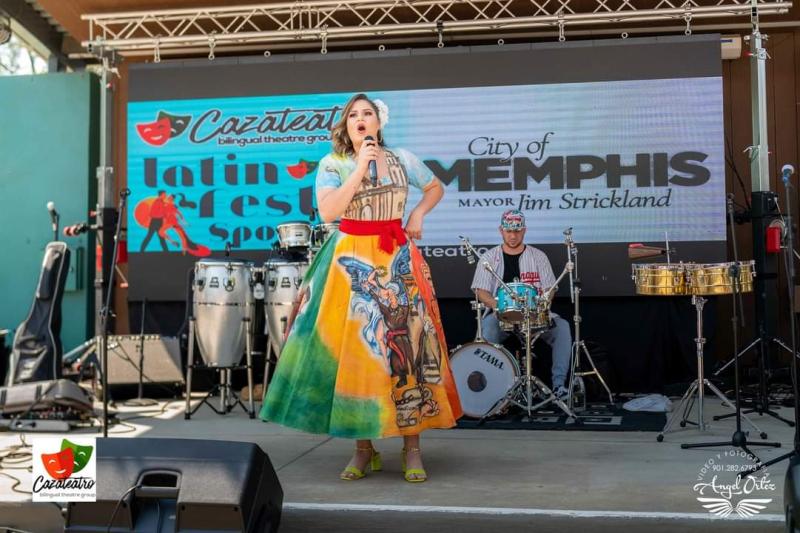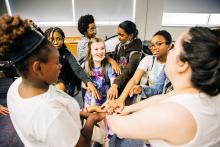ARP Grant Spotlight: ArtsMemphis (Memphis, TN)

Cazateatro Bilingual Theater Group, an ArtsMemphis grantee, shares Hispanic-American culture through its annual Latin Fest, a celebration that commemorates Hispanic Heritage Month. Photo by Angel Ortez.
Arts and culture are the soul of Memphis, Tennessee. Known as the Home of the Blues and Birthplace of Rock ‘n’ Roll, music, art, food, dance, and culture have set a foundation that drives community, expression, and individuality. Over the past 60 years, ArtsMemphis has distributed more than $94 million in grants and resources to hundreds of arts organizations and artists that help set the stage for the celebration and recognition of these traditions.
In addition to supporting local arts organizations, in 2020, ArtsMemphis made a renewed commitment to advancing equitable and inclusive access to the arts for all members in its community. This commitment became even more crucial to their vision as arts organizations across Memphis feared organizational closures and faced lost revenue during the pandemic.
ArtsMemphis estimates a pandemic-related loss of $24 million in income for the Memphis and Shelby County arts community in 2020. Many arts organizations laid off or furloughed about 20 percent of their employees at the beginning of the pandemic and were forced to find creative ways to keep their doors open. Some arts organizations turned to increased digital access and relied on their community for support, while others looked to their local arts agency for resources and guidance.
A large portion of the Memphis recovery effort was led by ArtsMemphis, which partnered with the Memphis Music Initiative and Music Export Memphis to allocate $1.8 million to an Arts Recovery Fund. That funding also included a $500,000 American Rescue Plan grant from the National Endowment for the Arts, $450,000 of which was subgranted to 36 arts organizations. The focus of the fund was, and still is, to support individual artists and arts organizations, particularly those that had fewer opportunities for government relief funding due to capacity or revenue.
“In March of 2020, arts organizations of all sizes and of all artistic disciplines started coming together to meet every other week, we listened to their concerns and made decisions based on what we heard,” Tracy Lauritzen Wright, Chief Operating Officer, said. “It was comforting for organizations to realize that they weren’t alone in trying to figure out next steps.”
These listening sessions also further empowered ArtsMemphis to distribute funds to traditionally under resourced organizations. Forty-seven percent of the American Rescue Plan funds were distributed to Black, Indigenous, People of Color (BIPOC) led or serving organizations, and 24 percent were distributed to organizations that serve an audience that is majority people of color. Thanks to these investments, Memphis’ arts organizations were able to keep staff employed and operational expenses paid.
“During the pandemic there were many ways for organizations to receive funding, but as a Local Arts Agency we were able to support organizations who didn’t find help through other federal or state grants. It was our focus to deepen our support of small, impactful organizations and those who had found really creative ways to stay afloat,” said Elizabeth Rouse, president and CEO of ArtsMemphis.
ArtsMemphis’ commitment to inclusion and access to the arts for all members of the community also resulted in the facilitation of new collaborations and partnerships across artistic disciplines and zip codes.
“Arts leaders who didn’t know each other at all were all of a sudden going through the same things together,” Rouse said. “In many ways, I think the arts community is more connected and working together more closely. Our organizations are much more flexible and adaptable and interested in collaboration now. While this process has been organic, and not a formal program, I think ArtsMemphis has played a role in helping various types of artistic disciplines and leaders be connected during the pandemic, and we're starting to see some of the results of that actually play out in the programming that groups are doing now. In a lot of ways, the arts are almost more accessible now than they were before the pandemic because arts organizations are changing how they deliver those opportunities.”
For example, one organization, Carpenter Art Garden, located in the Binghampton neighborhood, became a hub during the pandemic, distributing food, masks, and then vaccines. This was a step beyond their traditional role in the community of providing after-school activities and classes, vocational training for teens, and freshly grown produce. The organization, which was started in 2012 with one weekly outdoor art class and some picnic tables, is now a colorful oasis with hand-painted signs and décor, and plots overflowing with greenery.
“Just thinking about the role that organizations, that were basically unheard of to most of our community before the pandemic, have played is inspirational. These groups transformed into being a central resource for their neighborhoods during a really challenging time,” said Rouse.
From local arts organizations to individual artists, Memphis’ local arts sector is vibrant, innovative and working to move forward from the pandemic. In the next few years, ArtsMemphis hopes to return to pre-pandemic grant-making levels and continue to grow in their ability to support artists and organizations that make Tennessee a significant hub of arts and culture in Tennessee.
“For me, ‘being back’ will mean doing even more than we were before. That means supporting individual artists, that means pushing for inclusion and accessibility for everyone, that means doing all the things we thought we couldn’t do before the pandemic, but made happen because we had to; and that’s pretty fun,” said Lauritzen Wright.





